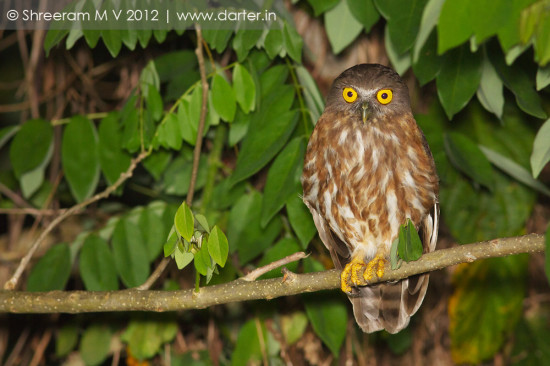Our previous post in this series was about a diurnal (day-time) predator in the forests of Andamans – Andaman Serpent Eagle. This week we look at a mysterious nocturnal predator.
Craaaw. The call came all of a sudden. Soft and mellow, totally unlike the harsh call of a crow. It was well past sunset and we were walking along the edges of the forest in South Andaman. We used our torchlights to survey all the trees around us. No sign of the bird.
And then the call came again. This time from very close-by. And then again. Soon, it became a repeated one. We began to search for the bird all around us but just couldn’t locate it. Close to 10 minutes later, we realized that the bird was just an arm’s length away from us and was calling from a branch a few feet above the ground! It was the endemic Andaman Hawk Owl (Ninox affinis).
The bird was actively looking all around, presumably, for prey. After gracing us with its presence for a few more minutes, the owl dived from its perch, picked up what looked like a grasshopper or praying mantis and disappeared into the thickets.
On our Emerald Isles tours, we have seen this bird at Mount Harriet National Park, Chidiya Tapu and Havelock Island. We’ve observed the bird at different heights of the canopy – from a few feet above the ground all the way to the canopy top. It often shares territories with the larger Hume’s Hawk Owl.
Ecology:
Andaman Hawk Owls inhabit the forests and secondary wood cover at Andaman. Very little is known about the feeding or breeding biology of this bird.
Conservation:
The Andaman Hawk Owl is classified as Near Threatened by IUCN. This is primarily due to the declining trend in its population and its restricted range where human activities are increasingly depleting forest cover.
We conduct Wildlife Photography Tours of Andamans during winters. Please visit our Emerald Isles page for more details on upcoming tours.
References:
- Richard Grimmett, Carol Inskipp, Tim Inskipp. Birds of the Indian Subcontinent (2nd Edition). Oxford University Press.
- BirdLife International (2013) Species factsheet: Ninox affinis. Downloaded from http://www.birdlife.org on 25/09/2013.

